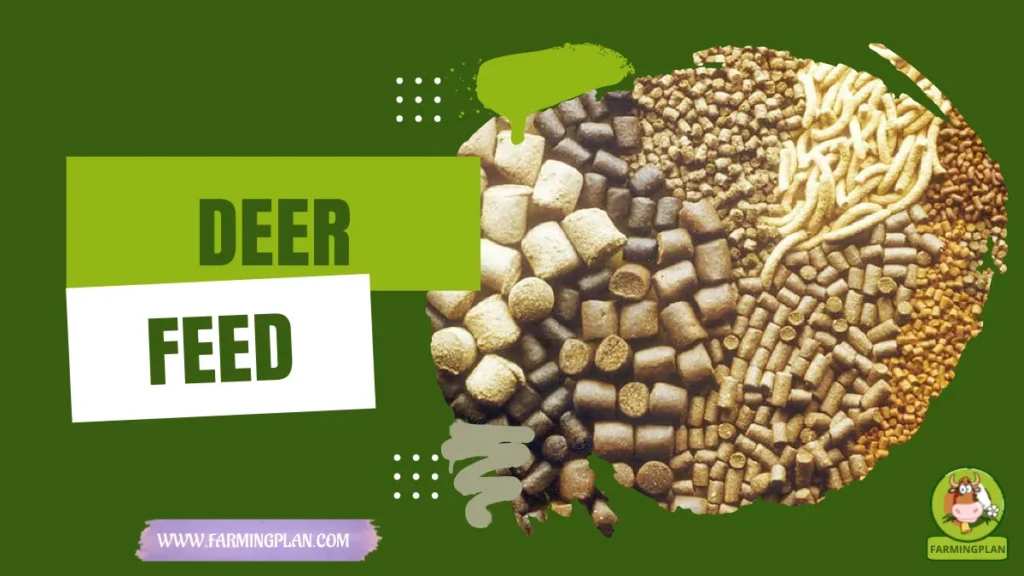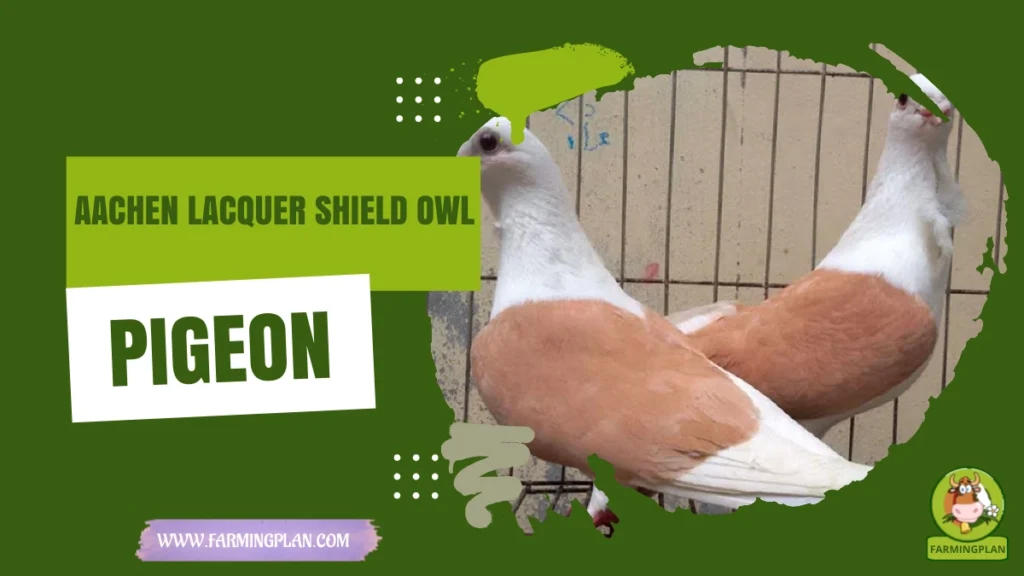The Austrian Pinscher Dog is a medium-sized breed with a big heart and an even bigger job. Known as an all-purpose farm dog, this loyal companion has roots that trace back to the farms of Austria. With its muscled body, alert eyes, and fearless nature, the Austrian Pinscher is more than just a pet—it’s a worker, a protector, and a friend. Its journey from the verge of extinction to becoming a favorite among active families and dog lovers is genuinely inspiring. You’re in the right place if you’ve ever been curious about this fantastic breed. Let’s explore what makes the Austrian Pinscher so special.
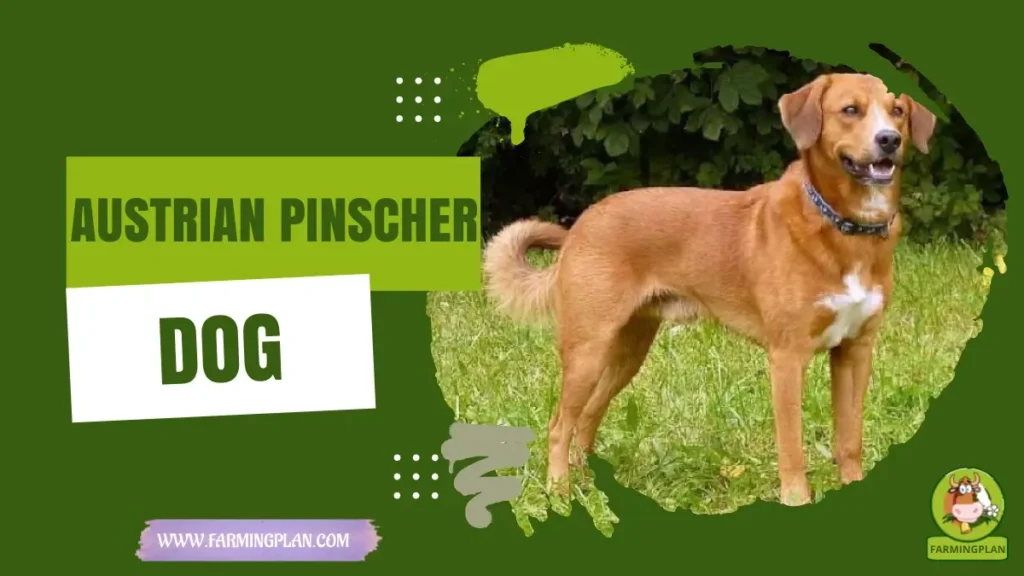
History and Origin of the Austrian Pinscher
The Austrian Pinscher Dog has a rich and meaningful past. This Austrian breed started its journey in the 19th century, living and working on farms across the countryside. These dogs were not pampered pets—they were real workers. They guarded property, herded animals, and warned farmers of danger.
A man named Emil Hauck played a massive role in shaping this breed. He began collecting these native dogs to save them from disappearing. He succeeded in his dream of developing a dog that fit a definite breed standard. Over time, the Austrian Pinscher dog became a recognized medium-sized breed of pinscher-type dog.
But things changed in the 20th century. The Austrian Pinscher dog nearly vanished as cities grew and machines replaced farm help. By the mid-1900s, it was on the verge of extinction. That’s when groups like Arche Austria (also called Ark Austria) stepped in. They helped bring the breed back through careful breed restoration breeding. Today, the Austrian Pinscher dog is known as a separate breed from German Pinschers. Its strong roots in German-speaking countries and deep ties to Austria make it one of Europe’s most treasured indigenous breeds.
Reads More: Ancona Chicken: 7 Amazing Benefits You Can’t Miss
“An Austrian Pinscher Dog is more than just a dog; it’s a loyal partner who will guard your home and fill your life with energy and love.”
Characteristics and Appearance Austrian pinscher dog
The Austrian Pinscher Dog is a strong, bold, and eye-catching dog. This medium-sized dog weighs between 26 to 40 lbs and has a body built for work. Its muscled body and square shape give it a powerful look, while its lively eyes show off its sharp mind.
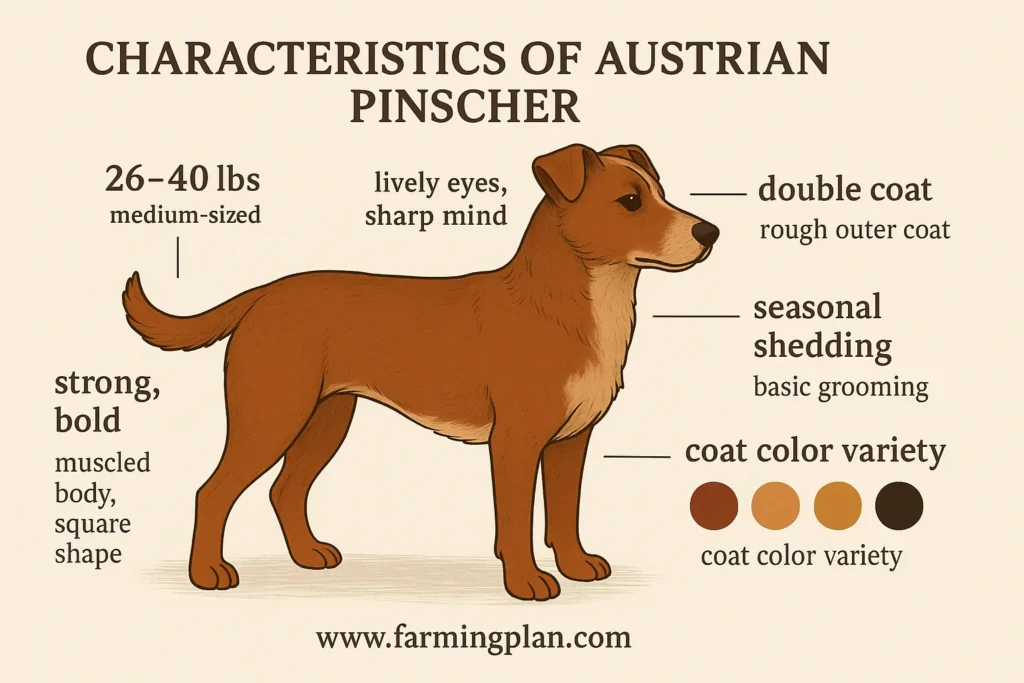
One of its most talked-about features is the double coat. This coat has a rough outer layer that protects it from harsh weather and dirt. During the coat change period, it sheds more and needs extra brushing. Excessive grooming isn’t required, though—just basic care will.
When it comes to coat color, the Austrian Pinscher dog has many. Standard coat colors include red, tan, yellow, and even black with markings. No matter the color, their coat type helps them stay warm in winter and cool in summer.
The Austrian Pinscher Dog appearance fits the definite breed standard set by dog organizations. Every part of their body—from their tail to their ears—shows they were made for farm life. These dogs are not just good-looking. They are built to work, guard, and stay active all day.
Nature and Temperament
The Austrian Pinscher Dog is known for its strong personality and loyal heart. This breed was made to be an incorruptible guard but also a pleasant companion for families. It has a bold spirit and loves having a job to do.
These dogs are full of energy. They do best with active families or people who spend much time outdoors. As an all-purpose farm dog, they enjoy running, chasing, and watching over their space. They’re always alert, which makes them great property guards.
Despite their protective nature, Austrian Pinschers are friendly with their people. They form close bonds and become loyal companions. They are intelligent and confident but need a consistent trainer to bring out their best behavior.
They may act cautiously around strangers, but they are not aggressive. That natural watchfulness makes them the perfect dogs on farms. With the right training and social time, they can be excellent guard dogs and trusted family pets.
Feeding and Diet Needs
Feeding an Austrian Pinscher Dog the right way helps keep it healthy and active. This breed needs a balanced diet to support its muscled body and high energy levels. Since it works hard and stays alert, proper nutrition is a must.
Use high-quality dry or wet dog food with real meat as the first ingredient. Protein is essential for muscle health. Add healthy fats and vegetables for extra energy. Dogs who live on farms or do agility training may need slightly more food than house pets. Keep feeding on a regular schedule, usually twice a day. Avoid table scraps or fatty treats, as this can cause weight gain. Clean, fresh water should always be available.
Adding omega-3 oils can support skin and coat health during the coat change period. This helps reduce shedding and keeps the double coat shiny. Avoid using too many grooming products that contain chemicals, especially during sensitive times. A healthy breed like the Austrian Pinscher dog does not need a fancy or expensive diet—just wise choices and portion control.
Uses & Roles of the Austrian Pinscher Dog
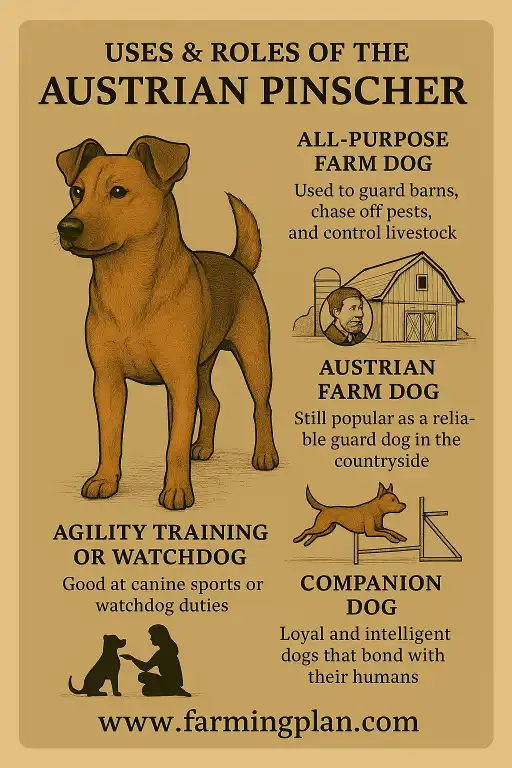
The Austrian Pinscher dog was born to work. Its main job was as an all-purpose farm dog, and it still shines in that role today. These dogs were used to guard barns, chase off pests, and help control livestock. Because of their bold nature when protecting the land, they were often called farm biters.
In today’s world, they’re still popular as Austrian farm dogs. They’re perfect for people who live in the countryside and need a reliable guard dog. Their alert nature makes them great at guard duties, but they also enjoy being family pets.
Some people choose Austrian Pinschers for agility training or as watchdogs in active families. They are quick learners and enjoy physical activity. This makes them great for sports or even obedience competitions.
Because of their loyalty and bond with their humans, many are kept as companion dogs, too. They can live in homes as long as they have space to run and play. These dogs are smart and confident and love to feel useful—whether it’s on a farm for herding or guarding the yard in a quiet neighborhood.
Reads More: Jersey Giant Chicken: The Best American Heritage Breed
Special Features and Strengths
The Austrian Pinscher Dog stands out with many rare and valuable traits. One of its strongest features is its role as an incorruptible guard. These dogs don’t back down easily. They take their job seriously and protect their home with a sharp focus. Their double coat is another strong point. It keeps them safe in all weather, whether it is raining, snowing, or hot outside.
This coat gives them comfort while they’re out doing farm work. It needs light care and does not need excessive grooming. Austrian Pinschers also have a bold and fearless attitude. They will bark to alert their owners but won’t attack without a reason, making them smart and safe protectors. Their strength, loyalty, and intelligence make them excellent guard dogs.
Another rare trait is their connection to native breeds. As a medium-sized breed of pinscher-type dogs, they represent an essential part of Austria’s farming past. Their strong body, keen senses, and emotional bond with humans make them workers and pleasant companions. They are easy to train during the training phase, especially with a consistent trainer. Their ability to learn fast makes them perfect for agility training or even simple farm tasks.
Health Issues and Prevention Tips
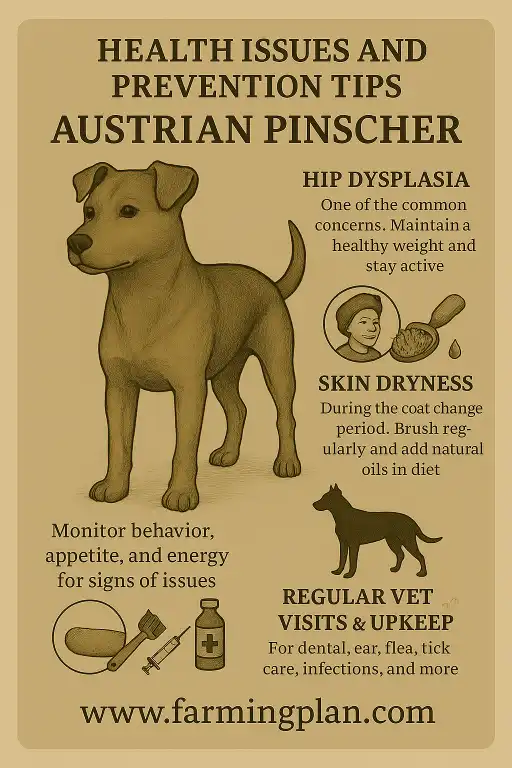
The Austrian Pinscher is known as a healthy breed, but like all dogs, it can suffer from a few minor health conditions. Most problems can be avoided or managed early with reasonable care and regular check-ups. One of the common concerns is hip dysplasia. This affects the joints and can cause pain or stiffness, especially in older dogs. To help prevent it, make sure your dog eats a balanced diet and stays active but not overworked. Keep them at a healthy weight to protect their joints.
Another issue can be skin dryness during the coat change period. Regular brushing and using natural oils in their diet can help keep their outer coat healthy. Avoid using too many grooming products, as some may irritate.
Always watch for changes in behavior, appetite, or energy. These could be signs of hidden health issues. Keeping up with vet visits and vaccinations helps protect them from infections or serious illnesses. Good health care also includes dental care, ear cleaning, and protection from fleas or ticks—especially for dogs living on farms. A clean space and proper food go a long way in keeping this indigenous breed strong and ready for work or play.
Step-by-Step Pet Owner Guide for Austrian Pinscher Care
Raising an Austrian Pinscher Dog can be an enriching experience, especially for active families or those who need a dependable farm companion. Here’s a step-by-step guide on properly caring for this energetic, loyal breed.
Step 1: Setting Up Their Space
Austrian Pinschers dog need space to move around and burn off their energy. If you have a backyard, ensure it’s secure so they can play safely. A fenced area is essential, as these dogs are quick and alert. Daily walks or trips to the park will be necessary if you live in a city.
Step 2: Nutrition & Feeding
Feed your Austrian Pinscher dog twice daily with high-quality dog food that includes real meat, healthy fats, and veggies. Make sure they have access to fresh water at all times. During the coat change period, adding omega-3 supplements will help maintain a healthy coat.
Step 3: Training & Socialization
Start training early. Consistency is key when raising an Austrian Pinscher dog. Use positive reinforcement and keep training sessions short but frequent. These dogs are intelligent and quick learners, especially when you give them a consistent trainer. Start with basic commands like sit, stay, and heel, then move on to agility training if your dog enjoys more challenge. Socialize your dog from an early age. Expose it to other pets, people, and different environments so it is well-adjusted and comfortable with change.
Step 4: Grooming & Coat Care
During the coat change period, you’ll need to brush your dog more often to keep the double coat looking neat. You don’t need to spend hours grooming, but regular brushing will help remove loose hair and keep the skin healthy. Avoid using harsh grooming products that may irritate their skin.
Step 5: Health Care & Vet Visits
Schedule annual check-ups with your vet to monitor for potential issues like hip dysplasia or skin conditions. Ensure your dog’s vaccinations are current, and ask about dental health and flea/tick prevention. Regular check-ups can catch any health issues early on and ensure a long, healthy life.
Step 6: Exercise & Mental Stimulation
These dogs are active and need both physical and mental exercise. Daily walks, runs, or playtime will keep them fit and happy. Consider agility training to challenge them mentally and physically. Keep their mind engaged with puzzles or new activities so they don’t get bored.
Expert Tips and Best Practices
These dogs are known for their incorruptible guard instincts and love for farm life. They’re strong and sturdy but also warm and friendly, making them perfect for guarding property and playing with kids. Whether you’re a farmer looking for a dependable guard dog or a pet owner wanting a rare and loyal friend, the Austrian Pinscher Dog might be just what you need. To get the most out of your Austrian Pinscher Dog, here are some pro tips and best practices from experienced breeders and dog owners:
Tip 1: Start Training Early
Austrian Pinscher dog is highly intelligent and love having a job to do. Training early is key to ensuring they grow up to be well-behaved. Start with basic commands like “sit,” “stay,” and “come” and gradually increase difficulty. Be consistent and patient.
Tip 2: Socialize for a Well-Rounded Dog
Socialization is critical for this breed. Expose your dog to various people, animals, and environments while it is young. This helps them grow into confident, friendly dogs comfortable in different settings.
Tip 3: Provide Mental and Physical Stimulation
This breed thrives on activity. Incorporate daily walks, runs, or play sessions into your routine. You can also try agility training or fetch to keep them mentally sharp and physically fit. Keep them busy to prevent boredom, which can lead to destructive behavior.
Tip 4: Regular Vet Visits for a Healthy Life
Ensure your Austrian Pinscher dog has regular vet check-ups, especially to monitor for conditions like hip dysplasia. Regular check-ups can help spot signs of health problems before they become significant. Keep up with vaccinations, flea/tick prevention, and grooming.
Tip 5: Create a Secure Environment
Whether you live on a farm or in the city, ensure your dog’s environment is secure. If you have a garden or backyard, install a fence to prevent them from running off. Their guarding instincts make them excellent protectors but must be safely contained.
Tip 6: Maintain a Balanced Diet
Proper diet is essential for your dog’s long-term health. Stick to high-quality dog food with natural ingredients, avoid overfeeding to prevent obesity, and make sure your dog always has access to fresh water.
By following these best practices, you’ll enjoy a long, happy life with your Austrian Pinscher dog, whether they’re working on the farm, running agility courses, or simply lounging as your loyal companion.
FAQs
1. What is the origin of the Austrian Pinscher?
The Austrian Pinscher originated in Austria as a farm dog, bred for tasks such as guarding barns, herding livestock, and controlling rodents.
2. Are Austrian Pinschers good family pets?
Austrian Pinschers are loyal and protective, making them excellent companions for active families. They thrive in environments where they can engage in regular exercise and mental stimulation.
3. What are common health issues in Austrian Pinschers?
While generally healthy, Austrian Pinschers can be prone to hip dysplasia and certain eye conditions. Regular veterinary check-ups are essential for early detection and treatment.
4. How much exercise do Austrian Pinschers need?
Austrian Pinschers are active dogs that require daily physical activity, including walks, runs, or play sessions. Engaging in dog sports like agility can also help meet their exercise needs.
5. Are Austrian Pinschers easy to train?
Austrian Pinschers are intelligent and respond well to positive reinforcement training methods. However, to prevent dominance issues, they require a confident and consistent handler.
Conclusion
The Austrian Pinscher is a versatile and loyal breed, initially developed for farm work in Austria. With a strong protective instinct, they make excellent companions for active families, provided they receive proper training and socialization. Their intelligence and energy require consistent mental and physical stimulation to prevent behavioral issues. Regular veterinary care is essential to monitor for potential health concerns. The Austrian Pinscher thrives in environments that offer companionship and purposeful activity.

